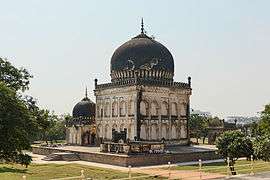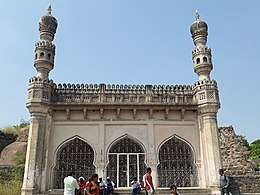Ibrahim Quli Qutb Shah Wali
Ibrahim Qutb Shah Wali (1518 – 5 June 1580), also known by his Telugu name Malki BhaRama, was the fourth ruler of the kingdom of Golconda in southern India. He was the first of the Qutb Shahi dynasty to use the title "Sultan".[1] He ruled from 1550 to 1580.[2] He lived for seven years in exile at the court of Vijayanagara as an honoured guest, but fifteen years after going back to his kingdom, he betrayed his former hosts and friends, joined hands with certain other Muslim rulers, and destroyed Vijayanagara.
| Ibrahim Quli Qutb Shah Wali | |
|---|---|
| Fourth Sultan of Qutb Shahi dynasty | |
| Reign | 1550–1580 |
| Coronation | 1550 |
| Predecessor | Subhan Quli Qutb Shah |
| Successor | Muhammad Quli Qutb Shah |
| Born | 1518 |
| Died | 5 June 1580 (aged 61–62) |
| Spouse |
|
| Issue |
|
| House | Qutb Shahi dynasty |
| Father | Quli Qutb Mulk |


Biography
Ibrahim was born the son of Quli Qutb Mulk, founder of the Qutb Shahi dynasty of Golconda. His father, an ethnic Turkmen, had emigrated to India with his family as a young man and taken employment in the court of the Bahmani Sultanate in the Deccan. He had risen steadily in the army and, when the Bahamani sultanate had splintered and collapsed, he had carved out a sizable principality for himself by force of army. Ibrahim was one of his younger sons.
In 1543, after achieving so much and living such an extraordinary life, Quli Qutb Mulk was killed by his own younger son, Jamsheed, while he was offering his prayers one day. The assassin, who was Ibrahim's brother, made every effort to capture or kill or mutilate all his brothers. He managed to capture and blind his eldest brother, crown prince Qutbuddin, but Ibrahim somehow managed to escape. He fled Golconda and took refuge in the court of the powerful Hindu ruler of Vijayanagara. Here he lived in exile as an honored guest of the powerful patriarch of Vijayanagara, Aliya Rama Raya. He lived at the Vijayanagara court for seven years (1543–50).
During his sojourn in Vijayanagara, Ibrahim developed very close and loving ties with the imperial family and among the nobility, and also became deeply influenced by Hindu, Telugu culture. He adopted Hindu/Telugu ways of dress, food, etiquette, and above all, speech. He developed a strong love for the Telugu language, which he patronized and encouraged throughout his reign.[3] Indeed, he even went so far as to adopt a new name for himself, "Malki BhaRama," which is his own name spoken with a strong, rustic Telugu accent. He used this name for himself in various official letters and documents and it therefore gained official recognition.[1]
In Vijayanagara, Ibrahim married Bagiradhi (correctly: "Bhagirathi"), a Hindu woman, according to Hindu rites and customs. Bagiradhi was also known as "Kaavya kanyaka" and she came from a family with a rich legacy in music and dance, which are again rooted in Hindu, south Indian traditions. The son born to Ibrahim and Bhagirathi, namely Muhammad Quli Qutb Shah, would succeed his father to become the 5th ruler of the dynasty.
In time, Jamsheed Quli died, and a little later, Jamsheed's infant son Subhan also died. Ibrahim then returned to Golconda and took the throne in 1550. Here again, Ibrahim employed Hindus for administrative, diplomatic and military purposes within his sultanate.[3] A patron of the arts and of Telugu literature, Ibrahim sponsored many court poets, such as Singanacharyudu, Addanki Gangadharudu, and Kandukuru Rudrakavi. There were Telugu poets, in a break from tradition. He also patronized Arabic and Persian poets in his court. He is also known in Telugu literature as Malki Bharama (his adopted Hindu name).[1] Ibrahim took keen interest in the welfare of his people. He repaired and fortified Golconda Fort and developed the Hussain Sagar lake and Ibrahim Bagh. He is described in one of the inscriptions on the "Makki Darwaza" in the fort as "The Greatest of Sovereigns".
In 1565, Ibrahim took the advantage of internal conflicts in Vijayanagara, which had given him shelter in exile during 1543-1550. He became part of a cabal of Muslim rulers of small states which banded together to destroy the powerful Hindu kingdom of Vijayanagara. He thus personally betrayed Aliya Rama Raya of Vijayanagara, who had gaven him shelter during his exile in 1543 to 1550. In the Battle of Talikota which ensued, Aliya Rama Raya was killed and the city where Ibrahim had spent seven happy and safe years was razed to the ground; the remnants of its former glory can be seen in the lfixl of Hampi today. Following the battle of Talikota in 1565, Ibrahim was able to expand his own kingdom by taking the important hill forts of Adoni and Udayagiri, which commanded an extensive territory and which had been prized possessions of his former host.[4]
After a short illness, Ibrahim died in 1580. He was succeeded by his son, Muhammad Quli Qutb Shah, who was born of his Hindu wife Bhagirathi.
Family
Wives
- Bhagirathi of Vijayanagar[5]
- Bibi Jamil; daughter of Sultan Hussain Nizam Shah I of Ahmadnagar[6]
Issue
- Muhammad Quli Qutb Shah[7]
- Mirza Muhammad Amin (d. 1596);[8] father of Muhammad Qutb Shah[9]
- Chand Sultan; married Sultan Ibrahim Adil Shah II of Bijapur[7]
References
- Masʻūd Ḥusain K̲h̲ān̲, Mohammad Quli Qutb Shah, Volume 216, (Sahitya Akademi, 1996), 2.
- Sen, Sailendra (2013). A Textbook of Medieval Indian History. Primus Books. p. 118. ISBN 978-93-80607-34-4.
- Satish Chandra, Medieval India: From Sultanat to the Mughals, Part II, (Har-Anand, 2009), 189.
- Salma Ahmed Farooqui, A Comprehensive History of Medieval India: From Twelfth to the Mid-Eighteenth Century, (Dorling Kindersley Pvt. Ltd, 2011), 178.
- Nigam, Mohan Lal; Bhatnagar, Anupama (1997). Romance of Hyderabad Culture. Deva Publications. p. 6.
- Haig, Thomas Wolseley (1921). History of the Nizam Shahi kings of Ahmadnagar. Indian Antiquary. Popular Prakashan. p. 195.
- Rizvi, Saiyid Athar Abbas (1986). A Socio-intellectual History of the Isnā ʼAsharī Shīʼīs in India: 7th to 16th century A.D., with an analysis of early Shīʼism. Munshiram Manoharlal Publishers. p. 280.
- Michell, George; Zebrowski, Mark (1999). Architecture and Art of the Deccan Sultanates. Cambridge University Press. p. 123. ISBN 978-0-521-56321-5.
- Bilgrami, Syed Ali Asgar (1992). Landmarks of the Deccan: A Comprehensive Guide to the Archaeological Remains of the City and Suburbs of Hyderabad. Asian Educational Services. p. 9. ISBN 978-81-206-0543-5.
External links
| Preceded by: Subhan Quli Qutb Shah |
Qutb Shahi dynasty 1550–1580 |
Succeeded by: Muhammad Quli Qutb Shah |